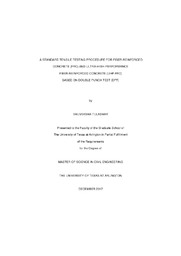
ATTENTION: The works hosted here are being migrated to a new repository that will consolidate resources, improve discoverability, and better show UTA's research impact on the global community. We will update authors as the migration progresses. Please see MavMatrix for more information.
Show simple item record
| dc.contributor.advisor | Chao, Shih-Ho | |
| dc.creator | Tuladhar, Shuveksha | |
| dc.date.accessioned | 2018-02-15T20:39:29Z | |
| dc.date.available | 2018-02-15T20:39:29Z | |
| dc.date.created | 2017-12 | |
| dc.date.issued | 2018-01-11 | |
| dc.date.submitted | December 2017 | |
| dc.identifier.uri | http://hdl.handle.net/10106/27185 | |
| dc.description.abstract | Current test methods such as ASTM 1609, ASTM 1550 and direct tensile test are used for evaluating the mechanical properties of Fiber Reinforced Concrete (FRC) and to determine the quality of mixture in design and construction practice. These test methods show high variability in the results, requires large specimen and complicated test setup. An ideal material test method for FRC should give consistent results in determining mechanical properties such as peak strength and residual strengths. Moreover, current test methods are expensive and time-consuming as more specimens are needed to acquire reliable test results. Double Punch Test (DPT) is a simple, reliable and consistent test method for evaluating the post-cracking behavior of FRC. DPT originally developed to determine the tensile strength of plain concrete, can also be used for evaluation of peak load and post-peak behavior of FRC and Ultra-High-Performance Fiber Reinforced Concrete (UHP-FRC). This method has a simple test setup and is easier to conduct in comparison to other test methods. DPT experimental test results are seen to be more consistent than the other test methods currently in practice. The simplicity of test setup, reliability of results (low scatter due to the higher cracking surface) and smaller specimens (fewer materials used) are the major advantages of using DPT method for evaluation of post cracking response of FRC and UHP-FRC. In this research, the application of double punch test is validated for FRC and the same method has been used and developed to confirm the suitability for UHP-FRC material in determining tensile strength and behavior in post cracking phase. There still exist some potential issue in the DPT method that needs to be resolved. The circumferential extensometer that is used to determine the total crack opening displacement in DPT is an expensive instrument. This limits the use of DPT method in most of the industrial and research laboratories. The measurement of crack width and inspection of a number of cracks are the important parameter for evaluating the characteristics of any concrete material. It is time-consuming to measure the crack width in a test by conventional visual inspection and automated crack width measurement is indispensable. This research mainly focuses on the deriving a simple formula for estimating average and maximum crack width using the axial deformation data and optimize the time taken for each DPT test. The relation would remove the need of using the expensive circumferential extensometer for the test. Thus, DPT could be used to evaluate and compare the quality of mixture for FRC and UHP-FRC by using a simple arrangement of LVDTs. | |
| dc.format.mimetype | application/pdf | |
| dc.language.iso | en_US | |
| dc.subject | Tensile test | |
| dc.subject | Fiber-reinforced concrete | |
| dc.subject | Ultra high performance fiber-reinforced concrete | |
| dc.subject | Double punch test | |
| dc.title | A Standard Tensile Testing Procedure for Fiber-reinforced Concrete (FRC) and Ultra-high-performance Fiber-reinforced Concrete (UHP-FRC) based on Double Punch Test (DPT) | |
| dc.type | Thesis | |
| dc.degree.department | Civil Engineering | |
| dc.degree.name | Master of Science in Civil Engineering | |
| dc.date.updated | 2018-02-15T20:41:37Z | |
| thesis.degree.department | Civil Engineering | |
| thesis.degree.grantor | The University of Texas at Arlington | |
| thesis.degree.level | Masters | |
| thesis.degree.name | Master of Science in Civil Engineering | |
| dc.type.material | text | |
Files in this item
- Name:
- TULADHAR-THESIS-2017.pdf
- Size:
- 7.320Mb
- Format:
- PDF
This item appears in the following Collection(s)
Show simple item record


